2014 FORD SUPER DUTY engine
[x] Cancel search: enginePage 21 of 82
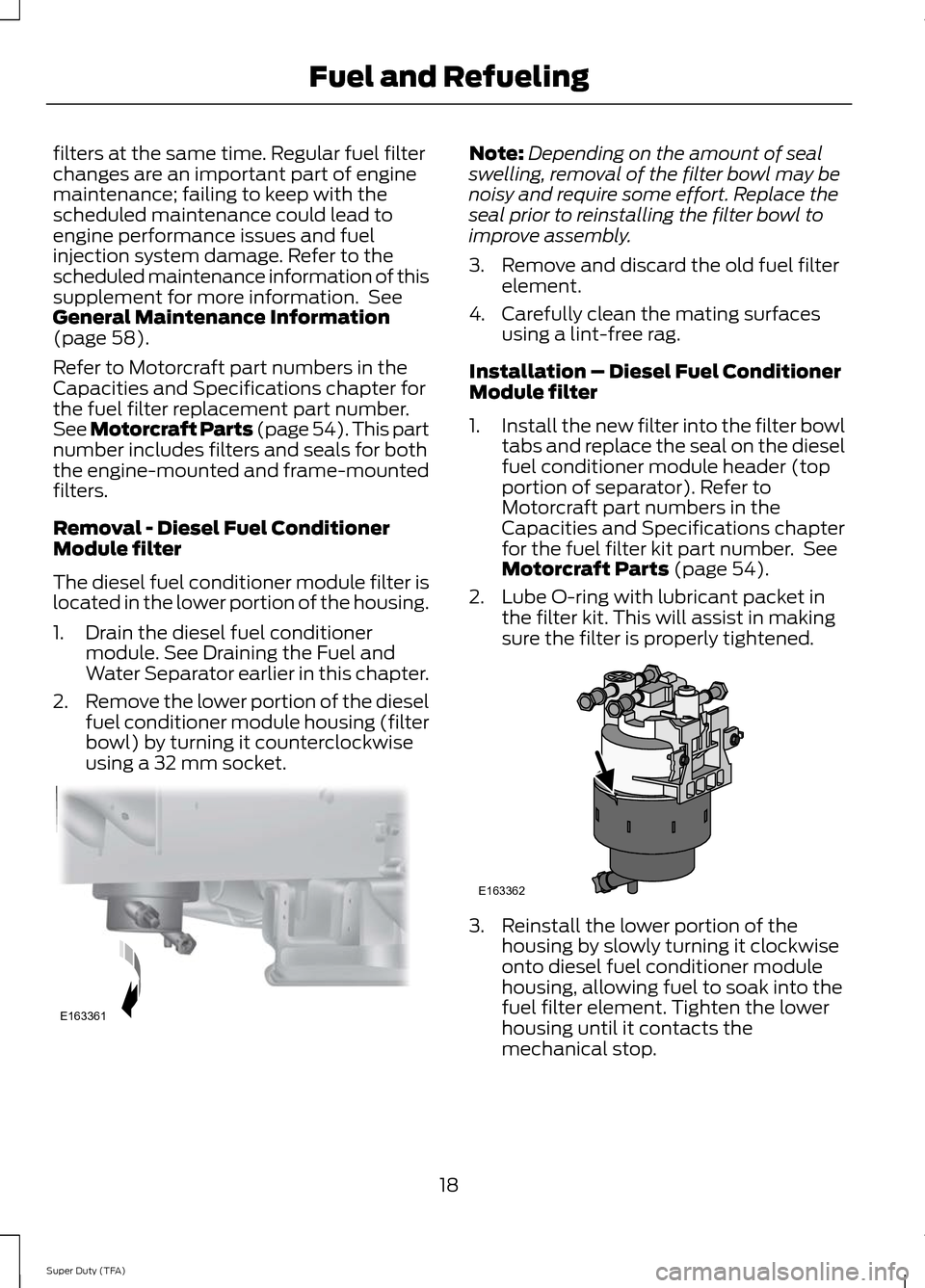
filters at the same time. Regular fuel filter
changes are an important part of engine
maintenance; failing to keep with the
scheduled maintenance could lead to
engine performance issues and fuel
injection system damage. Refer to the
scheduled maintenance information of this
supplement for more information. See
General Maintenance Information
(page 58).
Refer to Motorcraft part numbers in the
Capacities and Specifications chapter for
the fuel filter replacement part number.
See Motorcraft Parts (page 54). This part
number includes filters and seals for both
the engine-mounted and frame-mounted
filters.
Removal - Diesel Fuel Conditioner
Module filter
The diesel fuel conditioner module filter is
located in the lower portion of the housing.
1. Drain the diesel fuel conditioner module. See Draining the Fuel and
Water Separator earlier in this chapter.
2. Remove the lower portion of the diesel
fuel conditioner module housing (filter
bowl) by turning it counterclockwise
using a 32 mm socket. Note:
Depending on the amount of seal
swelling, removal of the filter bowl may be
noisy and require some effort. Replace the
seal prior to reinstalling the filter bowl to
improve assembly.
3. Remove and discard the old fuel filter element.
4. Carefully clean the mating surfaces using a lint-free rag.
Installation – Diesel Fuel Conditioner
Module filter
1. Install the new filter into the filter bowl
tabs and replace the seal on the diesel
fuel conditioner module header (top
portion of separator). Refer to
Motorcraft part numbers in the
Capacities and Specifications chapter
for the fuel filter kit part number. See
Motorcraft Parts
(page 54).
2. Lube O-ring with lubricant packet in the filter kit. This will assist in making
sure the filter is properly tightened. 3. Reinstall the lower portion of the
housing by slowly turning it clockwise
onto diesel fuel conditioner module
housing, allowing fuel to soak into the
fuel filter element. Tighten the lower
housing until it contacts the
mechanical stop.
18
Super Duty (TFA) Fuel and RefuelingE163361 E163362
Page 22 of 82
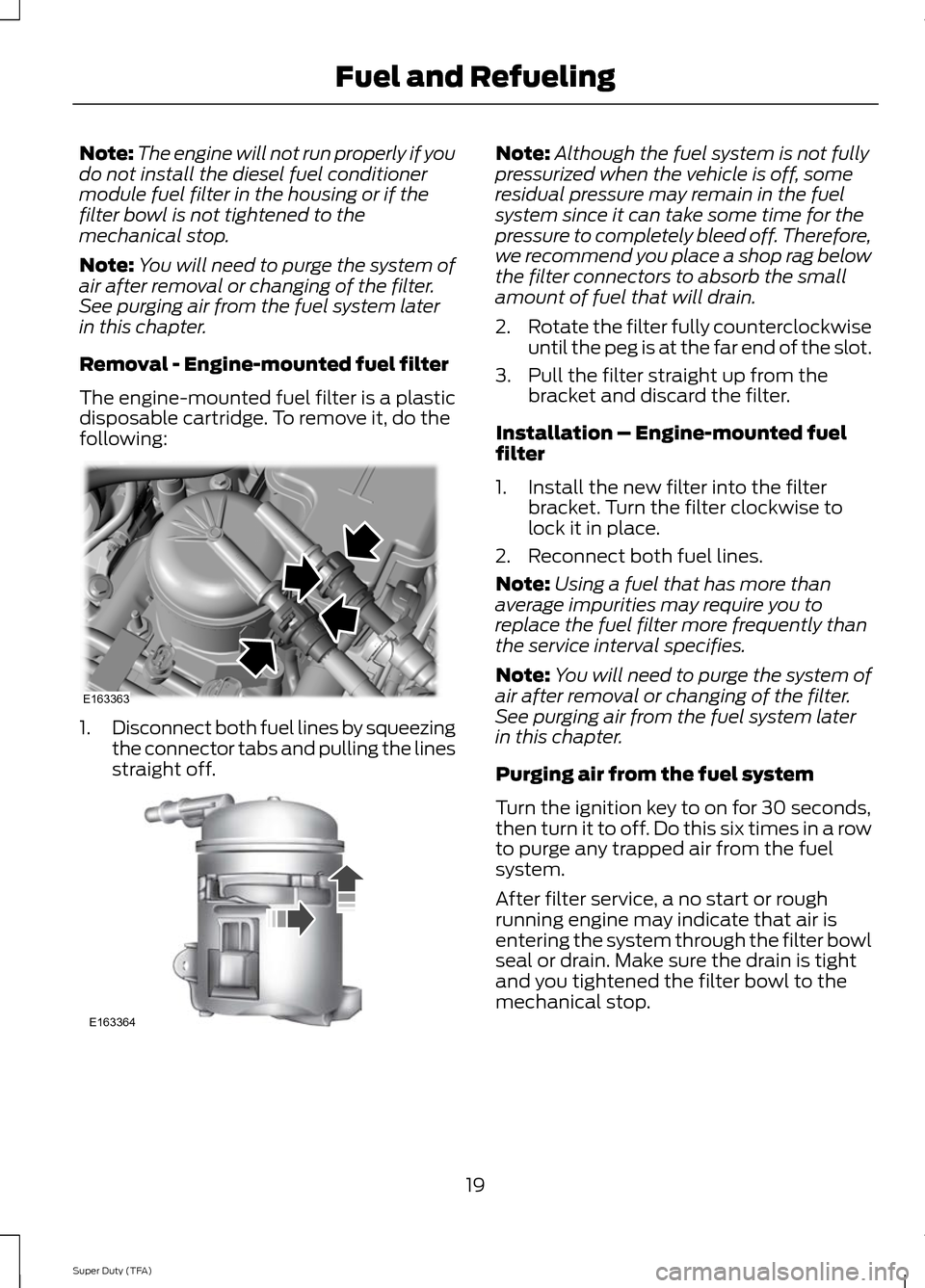
Note:
The engine will not run properly if you
do not install the diesel fuel conditioner
module fuel filter in the housing or if the
filter bowl is not tightened to the
mechanical stop.
Note: You will need to purge the system of
air after removal or changing of the filter.
See purging air from the fuel system later
in this chapter.
Removal - Engine-mounted fuel filter
The engine-mounted fuel filter is a plastic
disposable cartridge. To remove it, do the
following: 1.
Disconnect both fuel lines by squeezing
the connector tabs and pulling the lines
straight off. Note:
Although the fuel system is not fully
pressurized when the vehicle is off, some
residual pressure may remain in the fuel
system since it can take some time for the
pressure to completely bleed off. Therefore,
we recommend you place a shop rag below
the filter connectors to absorb the small
amount of fuel that will drain.
2. Rotate the filter fully counterclockwise
until the peg is at the far end of the slot.
3. Pull the filter straight up from the bracket and discard the filter.
Installation – Engine-mounted fuel
filter
1. Install the new filter into the filter bracket. Turn the filter clockwise to
lock it in place.
2. Reconnect both fuel lines.
Note: Using a fuel that has more than
average impurities may require you to
replace the fuel filter more frequently than
the service interval specifies.
Note: You will need to purge the system of
air after removal or changing of the filter.
See purging air from the fuel system later
in this chapter.
Purging air from the fuel system
Turn the ignition key to on for 30 seconds,
then turn it to off. Do this six times in a row
to purge any trapped air from the fuel
system.
After filter service, a no start or rough
running engine may indicate that air is
entering the system through the filter bowl
seal or drain. Make sure the drain is tight
and you tightened the filter bowl to the
mechanical stop.
19
Super Duty (TFA) Fuel and RefuelingE163363 E163364
Page 23 of 82
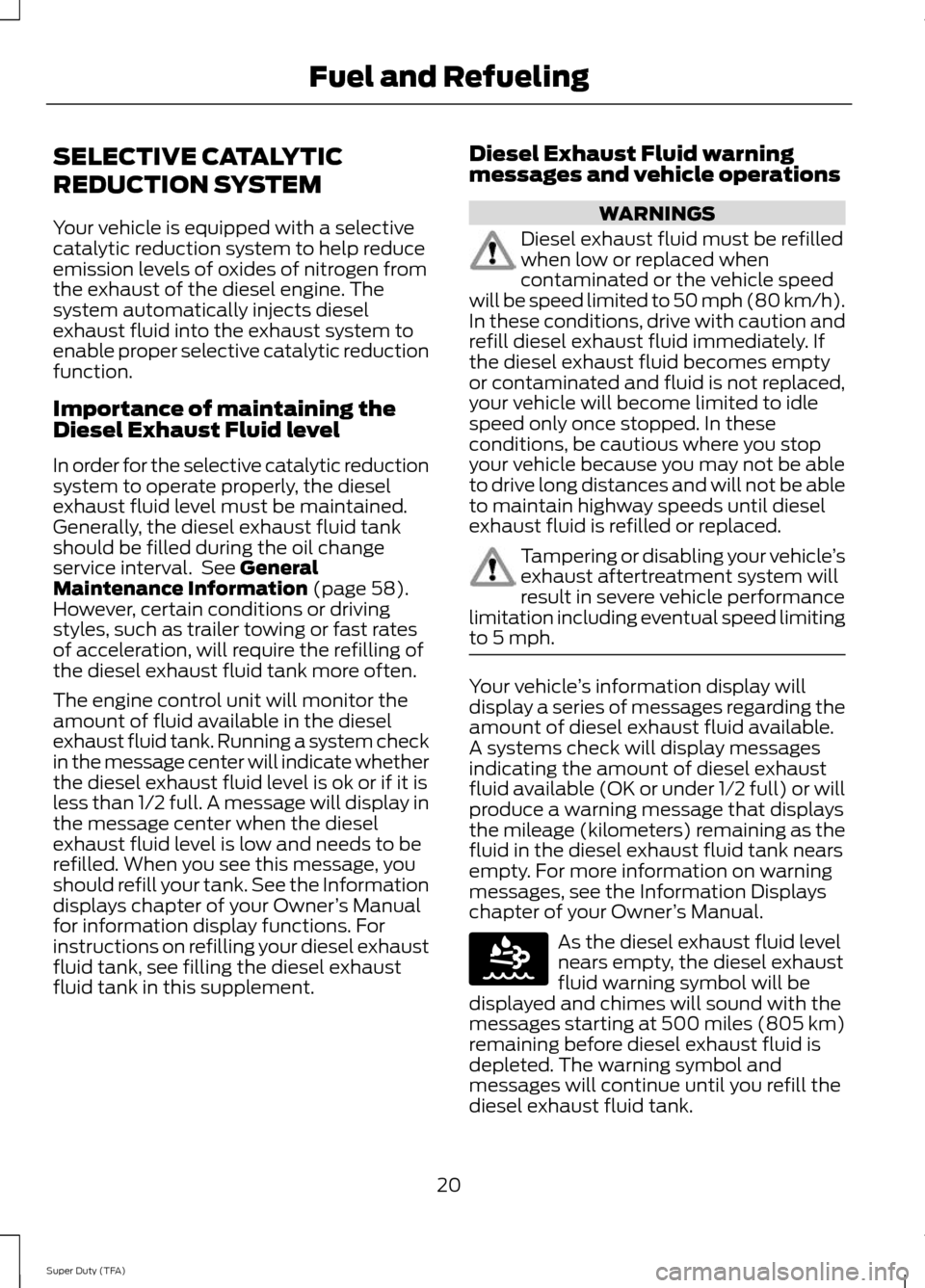
SELECTIVE CATALYTIC
REDUCTION SYSTEM
Your vehicle is equipped with a selective
catalytic reduction system to help reduce
emission levels of oxides of nitrogen from
the exhaust of the diesel engine. The
system automatically injects diesel
exhaust fluid into the exhaust system to
enable proper selective catalytic reduction
function.
Importance of maintaining the
Diesel Exhaust Fluid level
In order for the selective catalytic reduction
system to operate properly, the diesel
exhaust fluid level must be maintained.
Generally, the diesel exhaust fluid tank
should be filled during the oil change
service interval. See General
Maintenance Information (page 58).
However, certain conditions or driving
styles, such as trailer towing or fast rates
of acceleration, will require the refilling of
the diesel exhaust fluid tank more often.
The engine control unit will monitor the
amount of fluid available in the diesel
exhaust fluid tank. Running a system check
in the message center will indicate whether
the diesel exhaust fluid level is ok or if it is
less than 1/2 full. A message will display in
the message center when the diesel
exhaust fluid level is low and needs to be
refilled. When you see this message, you
should refill your tank. See the Information
displays chapter of your Owner ’s Manual
for information display functions. For
instructions on refilling your diesel exhaust
fluid tank, see filling the diesel exhaust
fluid tank in this supplement. Diesel Exhaust Fluid warning
messages and vehicle operations WARNINGS
Diesel exhaust fluid must be refilled
when low or replaced when
contaminated or the vehicle speed
will be speed limited to 50 mph (80 km/h).
In these conditions, drive with caution and
refill diesel exhaust fluid immediately. If
the diesel exhaust fluid becomes empty
or contaminated and fluid is not replaced,
your vehicle will become limited to idle
speed only once stopped. In these
conditions, be cautious where you stop
your vehicle because you may not be able
to drive long distances and will not be able
to maintain highway speeds until diesel
exhaust fluid is refilled or replaced. Tampering or disabling your vehicle
’s
exhaust aftertreatment system will
result in severe vehicle performance
limitation including eventual speed limiting
to 5 mph. Your vehicle
’s information display will
display a series of messages regarding the
amount of diesel exhaust fluid available.
A systems check will display messages
indicating the amount of diesel exhaust
fluid available (OK or under 1⁄2 full) or will
produce a warning message that displays
the mileage (kilometers) remaining as the
fluid in the diesel exhaust fluid tank nears
empty. For more information on warning
messages, see the Information Displays
chapter of your Owner ’s Manual. As the diesel exhaust fluid level
nears empty, the diesel exhaust
fluid warning symbol will be
displayed and chimes will sound with the
messages starting at 500 miles (805 km)
remaining before diesel exhaust fluid is
depleted. The warning symbol and
messages will continue until you refill the
diesel exhaust fluid tank.
20
Super Duty (TFA) Fuel and RefuelingE163176
Page 24 of 82
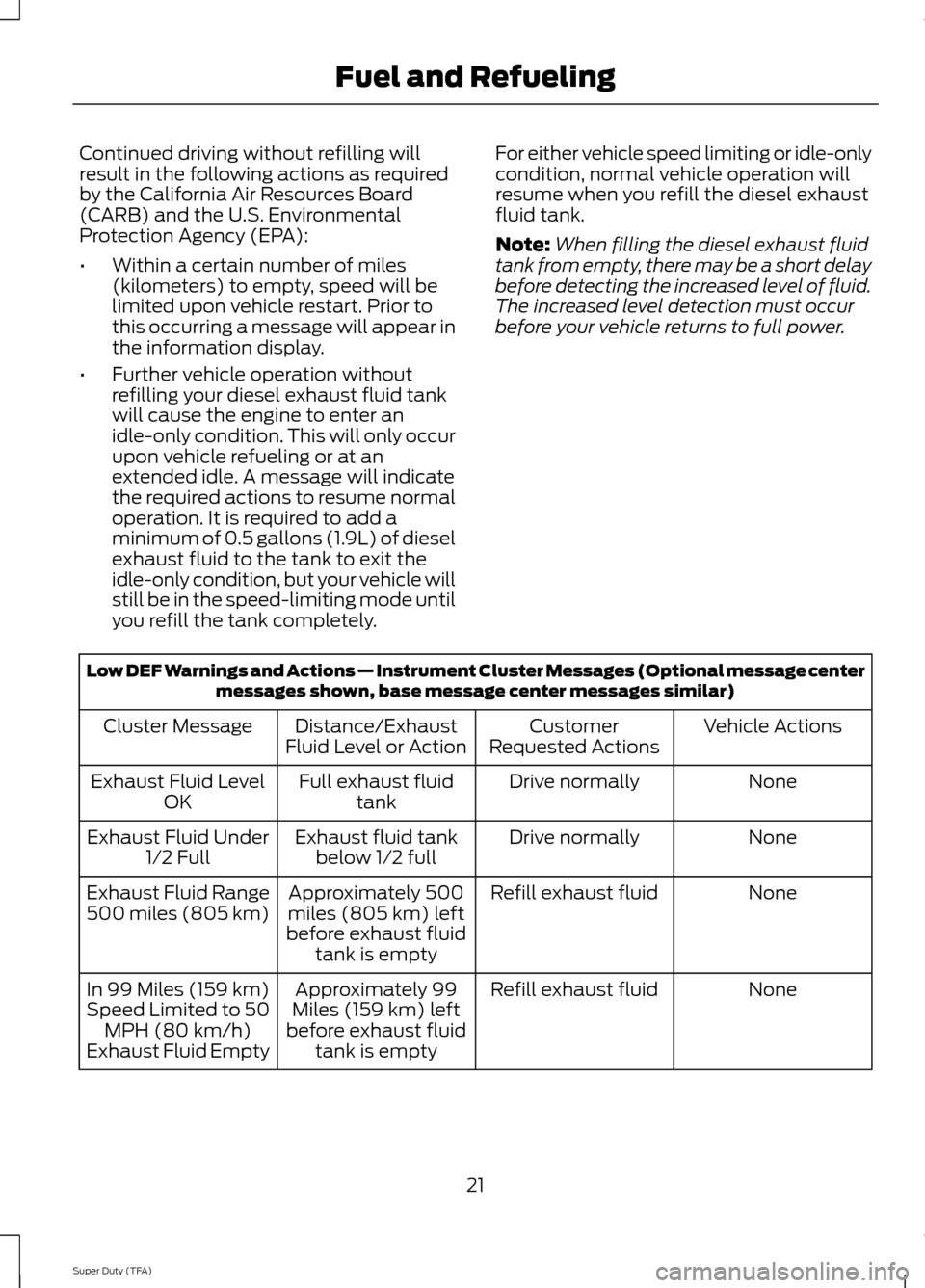
Continued driving without refilling will
result in the following actions as required
by the California Air Resources Board
(CARB) and the U.S. Environmental
Protection Agency (EPA):
•
Within a certain number of miles
(kilometers) to empty, speed will be
limited upon vehicle restart. Prior to
this occurring a message will appear in
the information display.
• Further vehicle operation without
refilling your diesel exhaust fluid tank
will cause the engine to enter an
idle-only condition. This will only occur
upon vehicle refueling or at an
extended idle. A message will indicate
the required actions to resume normal
operation. It is required to add a
minimum of 0.5 gallons (1.9L) of diesel
exhaust fluid to the tank to exit the
idle-only condition, but your vehicle will
still be in the speed-limiting mode until
you refill the tank completely. For either vehicle speed limiting or idle-only
condition, normal vehicle operation will
resume when you refill the diesel exhaust
fluid tank.
Note:
When filling the diesel exhaust fluid
tank from empty, there may be a short delay
before detecting the increased level of fluid.
The increased level detection must occur
before your vehicle returns to full power. Low DEF Warnings and Actions — Instrument Cluster Messages (Optional message center
messages shown, base message center messages similar)
Vehicle Actions
Customer
Requested Actions
Distance/Exhaust
Fluid Level or Action
Cluster Message
None
Drive normally
Full exhaust fluid
tank
Exhaust Fluid Level
OK
None
Drive normally
Exhaust fluid tank
below 1⁄2 full
Exhaust Fluid Under
1⁄2 Full
None
Refill exhaust fluid
Approximately 500
miles (805 km) left
before exhaust fluid tank is empty
Exhaust Fluid Range
500 miles (805 km)
None
Refill exhaust fluid
Approximately 99
Miles (159 km) left
before exhaust fluid tank is empty
In 99 Miles (159 km)
Speed Limited to 50
MPH (80 km/h)
Exhaust Fluid Empty
21
Super Duty (TFA) Fuel and Refueling
Page 25 of 82
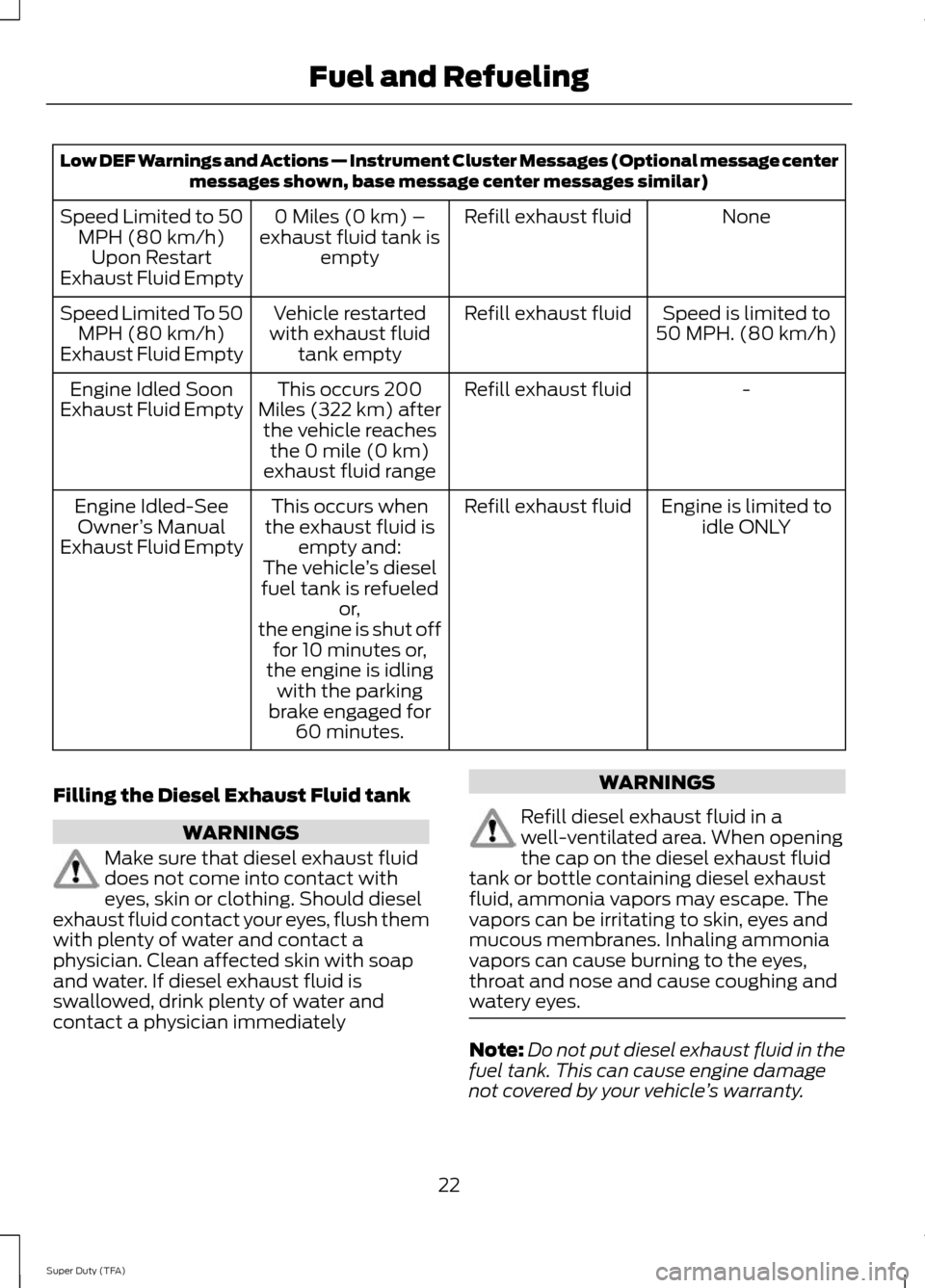
Low DEF Warnings and Actions — Instrument Cluster Messages (Optional message center
messages shown, base message center messages similar)
None
Refill exhaust fluid
0 Miles (0 km) –
exhaust fluid tank is empty
Speed Limited to 50
MPH (80 km/h)Upon Restart
Exhaust Fluid Empty
Speed is limited to
50 MPH. (80 km/h)
Refill exhaust fluid
Vehicle restarted
with exhaust fluid tank empty
Speed Limited To 50
MPH (80 km/h)
Exhaust Fluid Empty
-
Refill exhaust fluid
This occurs 200
Miles (322 km) after the vehicle reaches the 0 mile (0 km)
exhaust fluid range
Engine Idled Soon
Exhaust Fluid Empty
Engine is limited toidle ONLY
Refill exhaust fluid
This occurs when
the exhaust fluid is empty and:
Engine Idled-See
Owner ’s Manual
Exhaust Fluid Empty The vehicle’s diesel
fuel tank is refueled or,
the engine is shut off for 10 minutes or,
the engine is idling with the parking
brake engaged for 60 minutes.
Filling the Diesel Exhaust Fluid tank WARNINGS
Make sure that diesel exhaust fluid
does not come into contact with
eyes, skin or clothing. Should diesel
exhaust fluid contact your eyes, flush them
with plenty of water and contact a
physician. Clean affected skin with soap
and water. If diesel exhaust fluid is
swallowed, drink plenty of water and
contact a physician immediately WARNINGS
Refill diesel exhaust fluid in a
well-ventilated area. When opening
the cap on the diesel exhaust fluid
tank or bottle containing diesel exhaust
fluid, ammonia vapors may escape. The
vapors can be irritating to skin, eyes and
mucous membranes. Inhaling ammonia
vapors can cause burning to the eyes,
throat and nose and cause coughing and
watery eyes. Note:
Do not put diesel exhaust fluid in the
fuel tank. This can cause engine damage
not covered by your vehicle ’s warranty.
22
Super Duty (TFA) Fuel and Refueling
Page 27 of 82
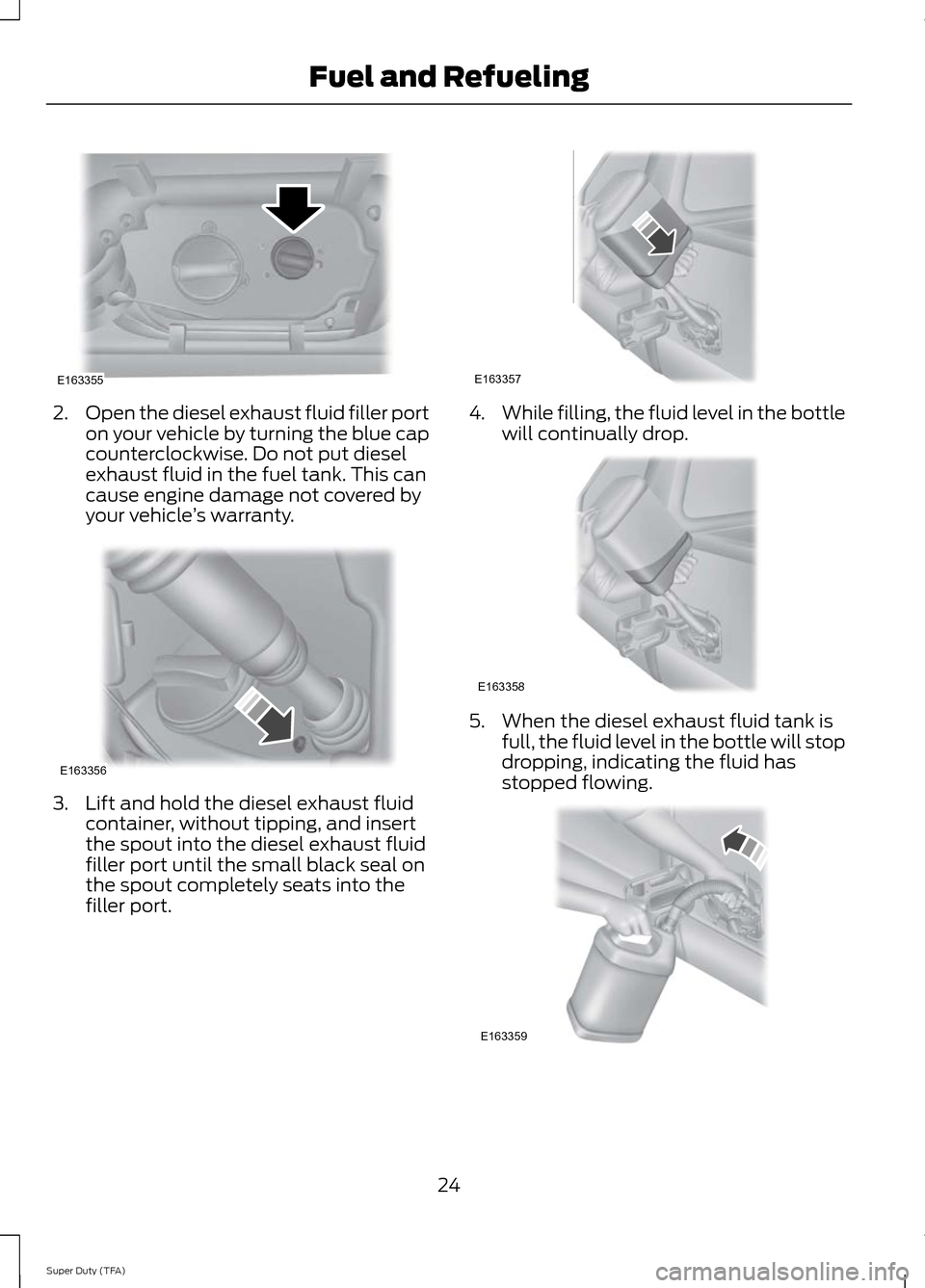
2.
Open the diesel exhaust fluid filler port
on your vehicle by turning the blue cap
counterclockwise. Do not put diesel
exhaust fluid in the fuel tank. This can
cause engine damage not covered by
your vehicle ’s warranty. 3. Lift and hold the diesel exhaust fluid
container, without tipping, and insert
the spout into the diesel exhaust fluid
filler port until the small black seal on
the spout completely seats into the
filler port. 4.
While filling, the fluid level in the bottle
will continually drop. 5. When the diesel exhaust fluid tank is
full, the fluid level in the bottle will stop
dropping, indicating the fluid has
stopped flowing. 24
Super Duty (TFA) Fuel and RefuelingE163355 E163356 E163357 E163358 E163359
Page 29 of 82

Continued driving without replacing diesel
exhaust fluid or having the selective
catalytic reduction system repaired will
result in the following actions as required
by the California Air Resources Board
(CARB) and U.S. Environmental Protection
Agency (EPA):
•
Within a certain number of miles
(kilometers) to empty, speed will be
limited upon restart. Prior to this
occurring a message will appear in the
information display.
• Further vehicle operation without
replacing contaminated diesel exhaust
fluid will cause the engine to enter an
idle-only condition. This will only occur
upon vehicle refueling, vehicle idling in
park for 1 hour, or engine shutdown for
10 minutes or more and will be
indicated by a message in the
information display indicating required
actions to resume normal operation.
For either vehicle speed limiting or idle-only
condition, normal vehicle operation will
resume when you repair the contaminated
system. To service a contaminated or
inoperative system, see an authorized
dealer.
Diesel Exhaust Fluid guidelines and
information
• Use only diesel exhaust fluid that
carries the trademark: American
Petroleum Institute (API) certified DEF
or ISO 22241.
• Do not put diesel exhaust fluid in the
diesel fuel tank.
• Do not overfill the diesel exhaust fluid
tank. •
Do not re-use the diesel exhaust fluid
container once it is emptied.
• Avoid spilling diesel exhaust fluid on
painted surfaces, carpeting or plastic
components. Immediately wipe away
any diesel exhaust fluid that has spilled
with a damp cloth and water. If it has
already crystallized, use warm water
and a sponge.
• Store diesel exhaust fluid out of direct
sunlight and in temperatures between
23°F (-5°C) — 68°F (20°C).
• Diesel exhaust fluid will freeze below
12°F (-11°C).
• Do not store the diesel exhaust fluid
bottle in your vehicle. If it leaks it could
cause damage to interior components
or release an ammonia odor inside your
vehicle.
• Diesel exhaust fluid is non-flammable,
non-toxic, colorless and water-soluble
liquid.
• Do not dilute diesel exhaust fluid with
water or any other liquid.
• An ammonia odor may be smelled
when the cap is removed or during
refill. Refill diesel exhaust fluid in a well
ventilated area.
Typical Diesel Exhaust Fluid Usage
The charts below illustrate approximate
diesel exhaust fluid usage for the given
distances traveled under various driving
conditions and when using the power take
off. Your usage may vary depending on:
driving style, trailer towing, loaded vehicle
weight, weather, idle time, PTO usage.
26
Super Duty (TFA) Fuel and Refueling
Page 31 of 82
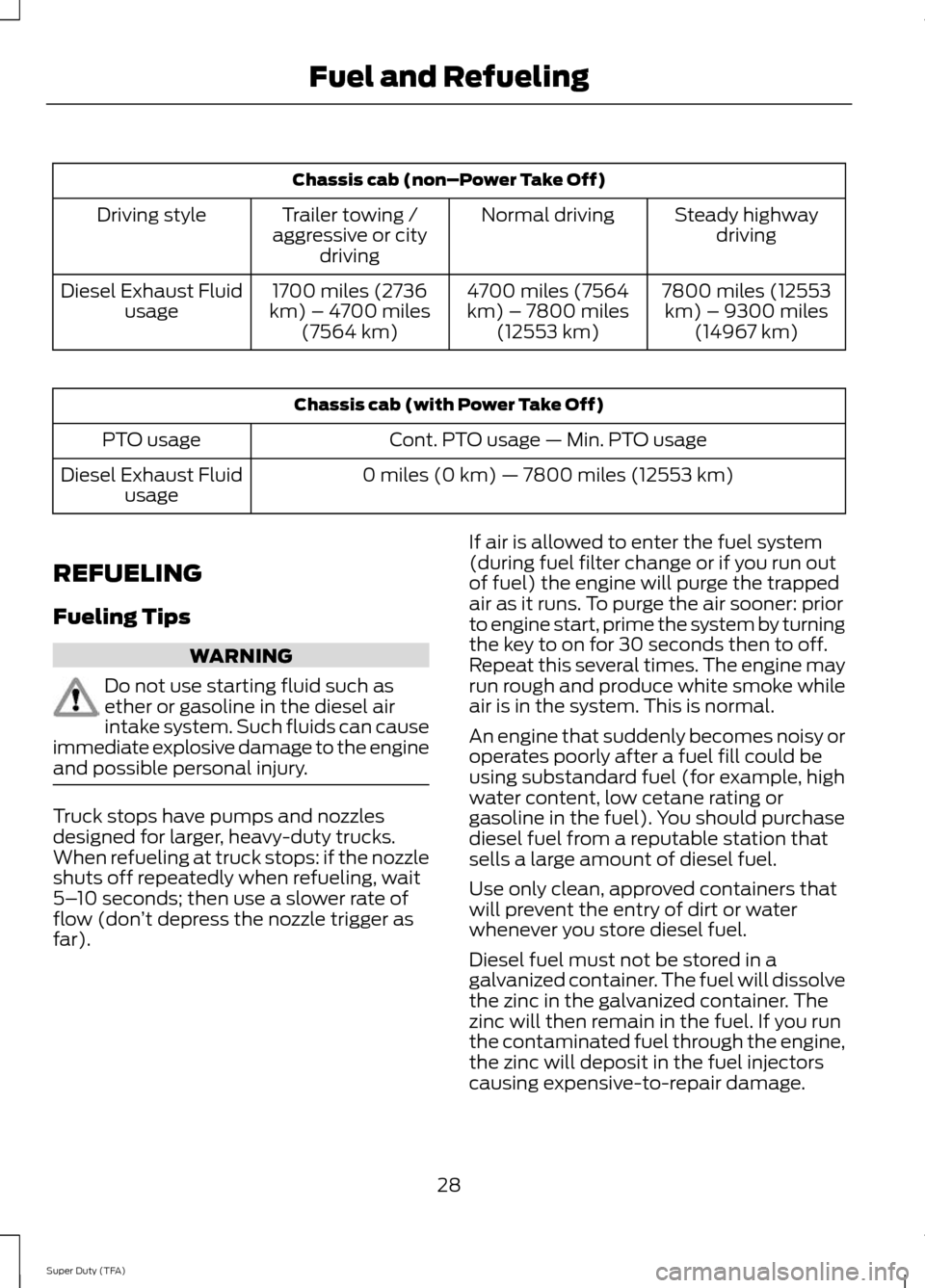
Chassis cab (non–Power Take Off)
Steady highwaydriving
Normal driving
Trailer towing /
aggressive or city driving
Driving style
7800 miles (12553km) – 9300 miles (14967 km)
4700 miles (7564
km) – 7800 miles (12553 km)
1700 miles (2736
km) – 4700 miles (7564 km)
Diesel Exhaust Fluid
usage Chassis cab (with Power Take Off)
Cont. PTO usage — Min. PTO usage
PTO usage
0 miles (0 km) — 7800 miles (12553 km)
Diesel Exhaust Fluid
usage
REFUELING
Fueling Tips WARNING
Do not use starting fluid such as
ether or gasoline in the diesel air
intake system. Such fluids can cause
immediate explosive damage to the engine
and possible personal injury. Truck stops have pumps and nozzles
designed for larger, heavy-duty trucks.
When refueling at truck stops: if the nozzle
shuts off repeatedly when refueling, wait
5–
10 seconds; then use a slower rate of
flow (don ’t depress the nozzle trigger as
far). If air is allowed to enter the fuel system
(during fuel filter change or if you run out
of fuel) the engine will purge the trapped
air as it runs. To purge the air sooner: prior
to engine start, prime the system by turning
the key to on for 30 seconds then to off.
Repeat this several times. The engine may
run rough and produce white smoke while
air is in the system. This is normal.
An engine that suddenly becomes noisy or
operates poorly after a fuel fill could be
using substandard fuel (for example, high
water content, low cetane rating or
gasoline in the fuel). You should purchase
diesel fuel from a reputable station that
sells a large amount of diesel fuel.
Use only clean, approved containers that
will prevent the entry of dirt or water
whenever you store diesel fuel.
Diesel fuel must not be stored in a
galvanized container. The fuel will dissolve
the zinc in the galvanized container. The
zinc will then remain in the fuel. If you run
the contaminated fuel through the engine,
the zinc will deposit in the fuel injectors
causing expensive-to-repair damage.
28
Super Duty (TFA) Fuel and Refueling